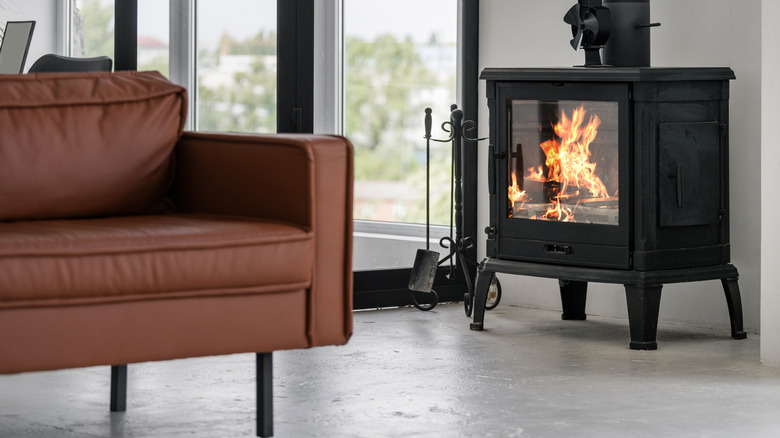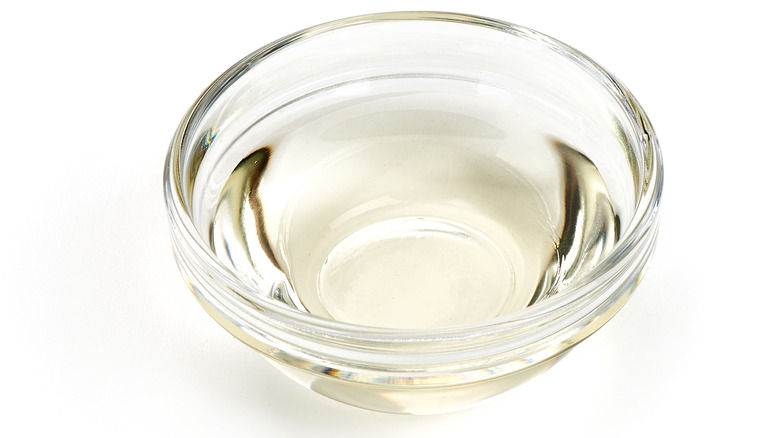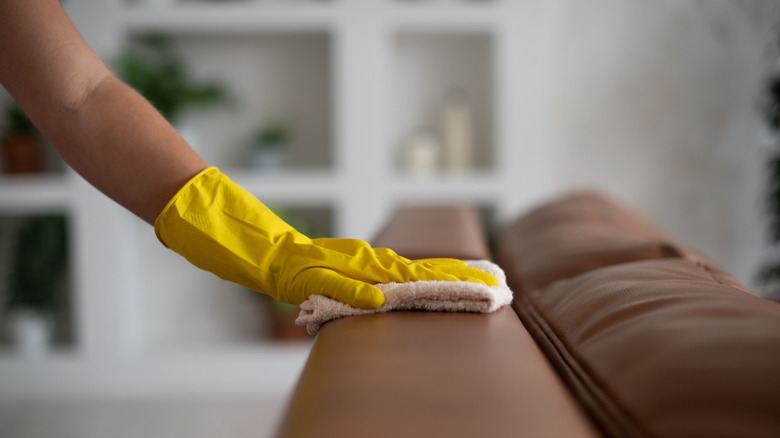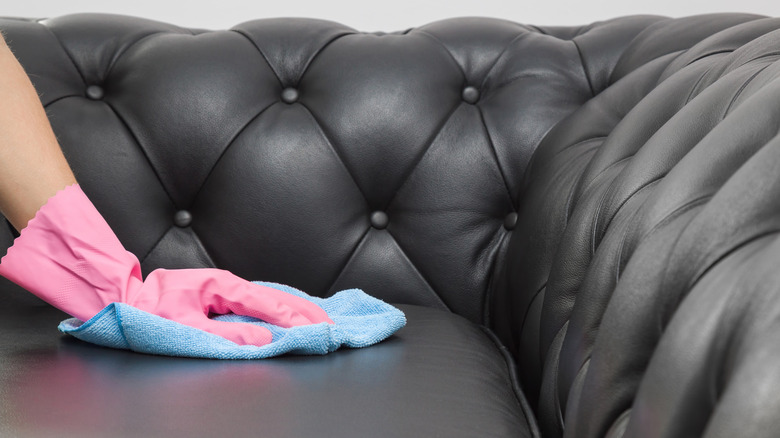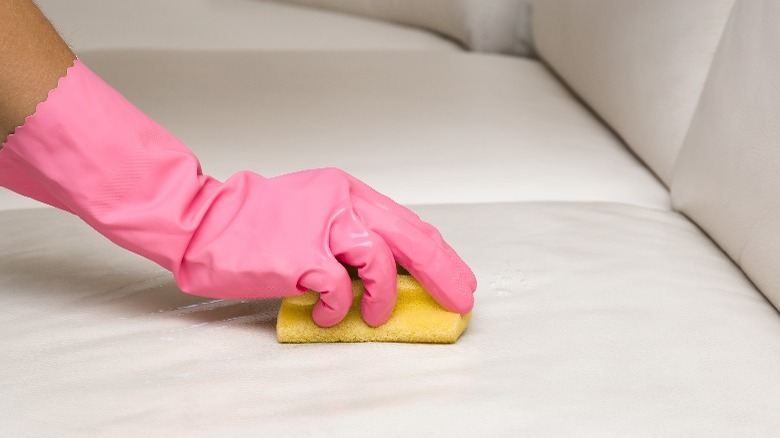The Best Cleaning Method For Leather Furniture
Nothing feels and smells like leather ... its supple texture is soft but not too smooth. That luxurious surface offers slight flexibility, and grain that warms to your touch. Besides its delightful feel, leather's scent evokes the best fragrances of autumn with the smoky musk that fills the crisp air. Some compare its aroma to an oak cask, just like the ones filled with fermenting wine, or the inside of a rustic cabin. Despite its affluent feel, there's some good news for fans of the material: Leather might seem high-maintenance based on its opulent character, but it offers a durable and easy-to-clean material, according to Bob Vila.
While there are a plethora of cleaners on the market, you can also use household supplies already stocked in your home (like vinegar, baking soda, and microfiber cloths) and, in less than 10 minutes, have a shining, stain-free piece of furniture. Whatever you choose, though, Liberty Leather Goods suggests making sure that you're using something gentle. Here are a few ways you can clean your leather furniture.
1. Try a rubdown with vinegar
For DIY'ers, vinegar is already a go-to when cleaning your home. Grab it from your cupboard, along with a small bucket, a microfiber cloth, and your vacuum. Use the brush attachment on your vacuum to lightly clean away any dust, dirt, and debris from your leather furniture before the big clean. Be sure to go under the cushions to get all those hidden crumbs. Then, wipe down the entire piece with the cloth for good measure.
Next, examine your furniture for its problem spots; these are the places you'll use the vinegar on. First, dilute it by mixing equal amounts of vinegar and water in your container. Next, take a cloth, wring out the excess water and wipe down anything still dirty. Make sure you rinse the cloth often, so you don't just move the dirt around. Never soak the material — sodden leather defeats the point of cleaning the material, according to Bob Vila. Natural Handyman points out that excess water can damage your furniture if it's more than a few drops that you can wipe up. If you leave the liquid on the couch or chair, it could create a moisture stain or the furniture can lose its color — so a light touch is recommended with this method.
2. Find a good commercial leather cleaner
Going DIY isn't for everyone. If you prefer a commercial cleaner, no worries, there are plenty to choose from. Each year publications review their top picks. Home Cleaning for You recommends purchasing a cleaner made specifically for the type of leather you want to freshen up. Leather comes in several varieties, such as:
- Protected or Pigmented Leather Furniture — Typically, the bulk of furniture, and car interiors, is this type. Cleansers for this material will include a silicone or polyurethane coating that helps the leather resist dirt.
- Aniline/Semi-Aniline Leather Furniture — This name refers to the Aniline dye used on this natural Napa material once the tanning process is completed, according to Best Leather. During this application, all the hide's markings and wrinkles become more noticeable and part of the design. You'll need a cleanser that leaves a protective sealant on this type of leather.
- Nubuck Leather Furniture — According to Holmes Leather Cleaning, this material uses sanded cowhide, and the nap created in the process makes it more durable than other leathers. The cleaner you'll use is similar to the one for aniline.
Besides always wiping down your furniture with the correct cleaner, you'll want to do a test strip before your first application to ensure you'll get the look desired, advised Home Cleaning for You. Then apply it on the rest of the furniture's leather using a microfiber cloth, moving along the leather's grain.
3. Use leather conditioner for restoring color and shine
"The best way to think of leather is that it is like your skin ... leather is a natural, breathable material; it changes over time," said furniture designer Timothy Oulton to Architectural Digest. Like your complexion, leather needs care — and moisture — to keep looking good. Part of your routine should offer a regular application of leather cream, every few weeks or monthly, depending on how frequently you use the furniture. This will keep the leather soft and clean off any dirt or marks and minimize scratches. You always want to test a small unobtrusive section before using the cream on the entire piece. Try to find an area in the back or bottom. Let it dry thoroughly before determining it is safe to administer. You don't want the conditioner to darken your furniture.
When rubbing the conditioner into the item, use just a little of the product at a time. Apply it with a soft cloth, then let it wend into the material. You should wipe down the furniture when finished to remove excess and buff if needed for a bright sheen. Conditioning leather offers it protection from body oils, various products, and other grime, said Furniture Fair. It also increases the longevity of the leather. Leather Honey recommends that those with sensitive skin wear protective gloves when using this product.
4. How to remove red wine stains from leather
Nothing feels worse than spilling a good glass of Cabernet on your favorite leather couch. Don't fret, though; just pour yourself another serving and do the following. You'll need some paper towels, regular table salt, and some soda water, according to Natural Handyman. First, get as much red wine out of the couch as possible by dabbing it with the towels. Use fresh ones often since sodden towels will only move the stain around rather than removing it.
Next, pour some table salt onto the stain, spread it evenly, and let it sit for 10 to 15 minutes to absorb the wine. Brush away the salt gently into a garbage container. If the spot is still moist, continue dabbing — never rub because this could deepen the stain. If the mark is still there, pour a tiny amount of soda water there. This should neutralize whatever remains. You'll want to dry the leather quickly with a towel so that the liquid does not set. If the area is too big for a towel, you can also use a hairdryer.
5. Avoid problems with correct furniture placement
Preventative care should be part of your leather maintenance. Where and how you place your leather furniture can extend or shorten its life, as well as how often you clean and condition it, according to HGTV. Take a look at where your furniture is or where you plan to put it — are their big windows filled with streaming light close by? If so, consider moving the location of your furniture or installing light-blocking curtains. The sun's warmth and its intense temperatures can cause leather to crack. In fact, any extreme hot or cold can hurt its longevity, so avoid radiators and air conditioners, too.
Be sure to put leather furniture in rooms that pets don't frequent, suggests Architectural Digest. Cats and dogs might look cute sitting on the couch, but they can scratch the material. Often their marks resist leather conditioners and will require professional care. Closing doors or banning your furry friends from the furniture helps.
6. How to get out stubborn stains
The secret to getting out an assortment of difficult stains is applying DIY remedies straight from your kitchen cabinets. Here's how to free your leather from ink, mold, and other maladies.
- Ink and mold — A little rubbing alcohol can tackle these marks. Apply a tiny amount on a cotton swab, and dab the blemish until it disappears.
- White and other light-colored leathers — These hues show smudges easily. Create a paste of equal parts using cream of tartar and lemon juice. Put this on the discoloration for about 10 minutes and then remove with a moistened towel.
- Grease — That slice of pizza seemed like a good idea until some grease dribbled onto your sofa, but you can solve this. First off, most recent stains can simply be wiped away with a clean and dry cloth. Do not use water with this process; the liquid allows grease to go deeper into the leather. If you don't notice the mark immediately, just sprinkle some baking soda on the older stain. This should absorb the grease, and you can brush it off using a dry dishrag after a few hours, according to Bob Vila. Better Homes & Garden also suggests using corn starch instead and vacuuming it up the next day.
Try consulting a professional for discolorations and marks you cannot remove with any of these techniques. You'll also want to go to a pro to repair any tears in your leather.

